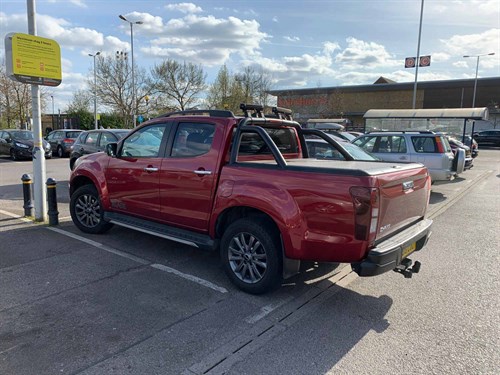- Renault gives UK debut to Master E-Tech at CV Show
- Isuzu D-Max long-term test – Latest Report
- Isuzu D-Max V-Cross Steel Edition revealed
- IVOTY Report: Stellantis explores the hydrogen proposition
- New Maxus EVs include eDeliver 5 van
- Used LCV values reach six-month high
- ADVERTISEMENT FEATURE: IVECO Daily Mission Awards 2024 Q2 Round-up: Grounds Maintenance & Forestry
- Stellantis Pro One electric vans review
- Mitie adds 5,000th EV to fleet
- Record number of CVs now on UK roads, SMMT reports
Isuzu D-Max (2018) long-term test - Final Report
Date: Wednesday, July 15, 2020 | Author: James Dallas

In my previous review of What Van?’s long-term D-Max Blade I reported on how the big truck was in its element in coping effortlessly with severe weather conditions, which created challenging driving conditions both on- and off-road.
Since then the Blade has mainly been confined to inner-city assignments, with the occasional jaunt along dual-carriageways and motorways thrown in. While not exactly a fish out of water in urban environments, the Blade can be awkward and cumbersome in certain situations.
Isuzu has always prided itself on the D-Max’s prowess as a capable and rugged working vehicle – it’s heartland is in rural areas, serving the likes of farmers, forestry workers and country vets, and this is reflected in the geographical make-up of the manufacturer’s retail network.
More recently, however, the brand has recognised that in order to increase sales volume it needs to grab a larger slice of the double-cab lifestyle market. It is one of the few pick-up brands (Ford and Toyota are others) that still offers single- and extended-cab trucks, but in the past few years Isuzu has supplemented its D-Max line-up with a procession of special-edition double-cab derivatives, which is how the Blade originated before taking over from the Utah as the top-of-the-range derivative.
This strategy makes sense in principle but could put the D-Max in danger of distancing itself from its core strength as a no-nonsense, competent workhorse.
It also demands that the flagship double-cab models, like the Blade, must face up to being scrutinised against the equivalent versions in rival manufacturer line-ups and run the risk of being found wanting by comparison.
The whole D-Max range is powered by the same 164hp 1.9-litre diesel engine. Although this drivetrain is a lot smoother than the 2.5 unit it replaced three years ago it is less refined than the 213hp 2.0 engine in the Ford Ranger Wildtrak, the 150hp 2.3 in the Mitsubishi L200 or the 163hp or 190hp 2.3 unit in the Nissan Navara, for example.
Nor is the six-speed automatic transmission in our Blade the slickest in town – it may be a close enough match for the auto gearbox in Toyota’s Hilux but is light years away from the eight-speed auto in Volkswagen’s Amarok or the 10-speed set-up in Ford’s Ranger. The drive can be lurchy as the transmission changes up through its cogs and a good deal of whining engine noise encroaches into the cabin.
The D-Max is hardly unique among pick-ups in being prone to understeer but this characteristic feels pronounced when negotiating tight urban streets. Parking can also be something of an ordeal, although it has to be said the task is made easier by sensors and an excellent reversing camera that provides a clear view of the space the vehicle has to squeeze into. The D-Max feels more at home when out on the open road, particularly when bowling along in straight lines as there can be a fair amount of body roll when cornering if you don’t ease off the accelerator.
Report Card: Refinement = 3/5
The Blade lacks the sophistication of some flagship rivals.
Isuzu D-Max Blade 1.9 Auto
Mileage 11,083
Official combined consumption 36.2mpg
Our average consumption 28.4mpg
Price range (ex VAT). £16,094-£35,334
Price (ex VAT) £29,809
Warranty 5yrs/125,000mls
Service intervals 12,000mls
Load length 1,485mm
Load width (min/max) 1,110/1,530mm
Gross payload 1,101kg
Engine size/power 1,898cc
Gearbox 6-spd auto
CO2 205g/km
Options (ex VAT)
Lazer lights sports bar £810
(See below for previous reports)
View The WhatVan Digital Edition


